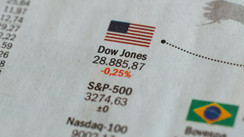Deceleration in Inflation Fuels Consumer Confidence
It was seen that the underlying inflation in the U.S. rose by 0.2% in December, as predicted. Many economists suggest that such rate, if maintained, could help rein in inflation, enabling it to inch back to the Federal Reserve's 2% goal.
In a year-over-year comparison, the 'core' personal consumption expenditures (PCE) price index, which leaves out fluctuating entities like food and fuel, reported an increase of 2.9% in December. This growth pace is a step down from November's 3.2%, and slightly below the 3.0% forecast.
Indication for the Federal Reserve's Tactic
An inflation indicator widely used by the Fed indicates a continuation of price expansion slowing down towards the central bank's year-on-year target of 2%.
The broader measure nudged up by 0.2% month on month, rebounding after dropping for the first time in over three and a half years in the preceding month. On an annual basis, it climbed by 2.6%, mimicking the pace of the former month, as a surge in food prices counterbalanced a decrease in energy costs. Both percentages aligned with predictions.
Consumer Spending Uptick and Possible Fed Rate Adjustments
The signs of past high inflation levels subsiding convinced American shoppers to shell out more during the holiday season. Consumer expenditure — accounting for over two-thirds of U.S.'s total economic activity — escalated by 0.7% compared to November's 0.4%. However, the individuals' savings rate dwindled to 3.7% from November’s 4.1%.
This data, along with Thursday's robust GDP numbers, could influence the Fed's approach towards potential interest rate reductions from its highest level in over two decades in the months ahead. Despite initial expectations of rate cuts as early as March, softened inflation and persistent economic growth have deferred these expectations. Based on the closely watched FedWatch Tool by the CME Group (NASDAQ:CME), financial markets forecast about a 51% possibility of a quarter-basis point decrease in May.
An Analyst's Vision on Fed's Handling of Inflation
Thomas Monteiro, a Senior Analyst at Investing.com, assessed that the core PCE figures indicate the Fed's strategy to control inflation without causing a recession, dubbed a "soft landing," is effectively operational on all aspects. Despite this, he suggested that there doesn't seem to be an immediate, pressing need for the Fed to act before summer since thebattle to control inflation, although seemingly under command, hasn’t concluded yet.
In the aftermath of the PCE numbers’ release, U.S. stock futures took a hit, and the dollar flexed down against a range of other currencies. Yields of the rate-sensitive 2-year and the benchmark 10-year U.S. treasury bonds, which usually move in the opposite direction to prices, inched upwards.





